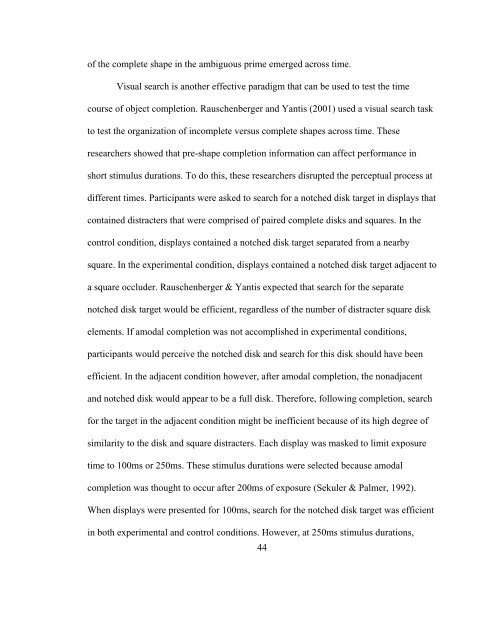The Use of Iambic Pentameter in the
The Use of Iambic Pentameter in the
The Use of Iambic Pentameter in the
You also want an ePaper? Increase the reach of your titles
YUMPU automatically turns print PDFs into web optimized ePapers that Google loves.
<strong>of</strong> <strong>the</strong> complete shape <strong>in</strong> <strong>the</strong> ambiguous prime emerged across time.<br />
Visual search is ano<strong>the</strong>r effective paradigm that can be used to test <strong>the</strong> time<br />
course <strong>of</strong> object completion. Rauschenberger and Yantis (2001) used a visual search task<br />
to test <strong>the</strong> organization <strong>of</strong> <strong>in</strong>complete versus complete shapes across time. <strong>The</strong>se<br />
researchers showed that pre-shape completion <strong>in</strong>formation can affect performance <strong>in</strong><br />
short stimulus durations. To do this, <strong>the</strong>se researchers disrupted <strong>the</strong> perceptual process at<br />
different times. Participants were asked to search for a notched disk target <strong>in</strong> displays that<br />
conta<strong>in</strong>ed distracters that were comprised <strong>of</strong> paired complete disks and squares. In <strong>the</strong><br />
control condition, displays conta<strong>in</strong>ed a notched disk target separated from a nearby<br />
square. In <strong>the</strong> experimental condition, displays conta<strong>in</strong>ed a notched disk target adjacent to<br />
a square occluder. Rauschenberger & Yantis expected that search for <strong>the</strong> separate<br />
notched disk target would be efficient, regardless <strong>of</strong> <strong>the</strong> number <strong>of</strong> distracter square disk<br />
elements. If amodal completion was not accomplished <strong>in</strong> experimental conditions,<br />
participants would perceive <strong>the</strong> notched disk and search for this disk should have been<br />
efficient. In <strong>the</strong> adjacent condition however, after amodal completion, <strong>the</strong> nonadjacent<br />
and notched disk would appear to be a full disk. <strong>The</strong>refore, follow<strong>in</strong>g completion, search<br />
for <strong>the</strong> target <strong>in</strong> <strong>the</strong> adjacent condition might be <strong>in</strong>efficient because <strong>of</strong> its high degree <strong>of</strong><br />
similarity to <strong>the</strong> disk and square distracters. Each display was masked to limit exposure<br />
time to 100ms or 250ms. <strong>The</strong>se stimulus durations were selected because amodal<br />
completion was thought to occur after 200ms <strong>of</strong> exposure (Sekuler & Palmer, 1992).<br />
When displays were presented for 100ms, search for <strong>the</strong> notched disk target was efficient<br />
<strong>in</strong> both experimental and control conditions. However, at 250ms stimulus durations,<br />
44

















